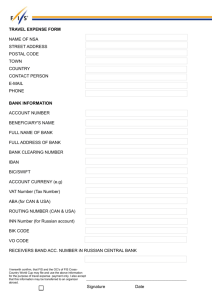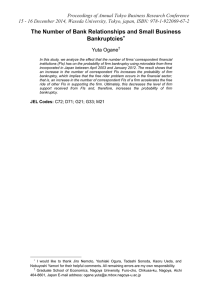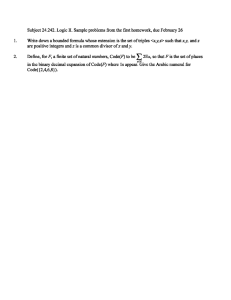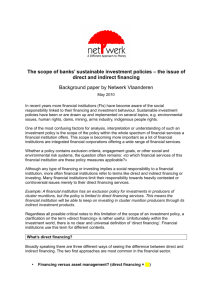APPENDIX A IEEE POWER QUALITY STANDARDS
advertisement
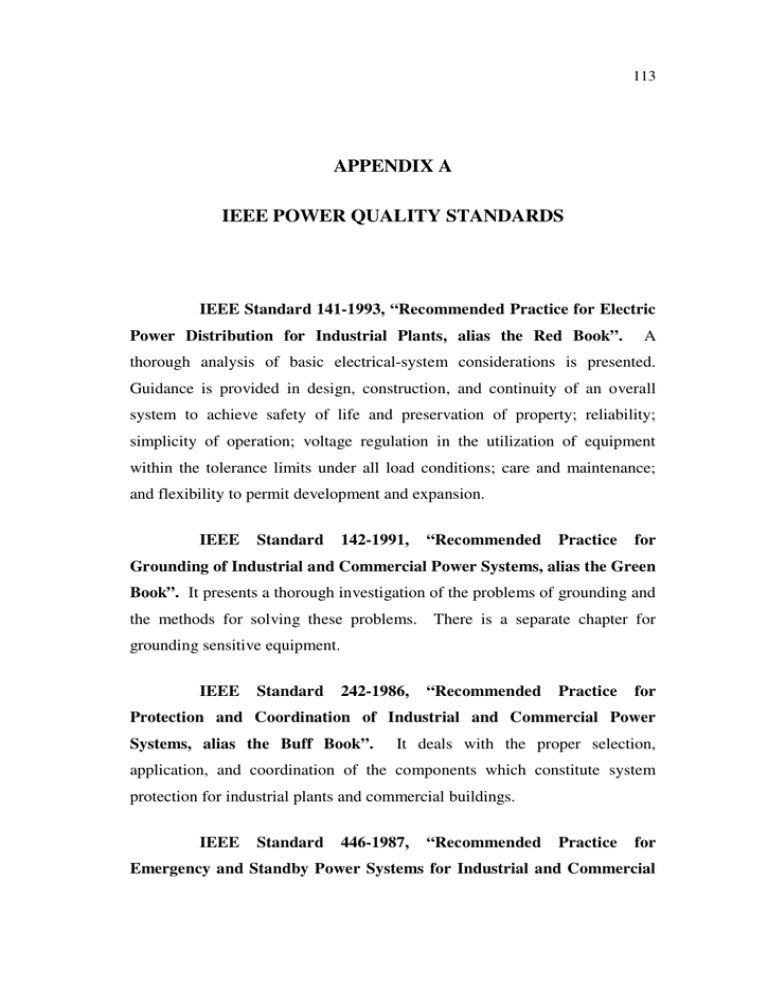
113 APPENDIX A IEEE POWER QUALITY STANDARDS IEEE Standard 141-1993, “Recommended Practice for Electric Power Distribution for Industrial Plants, alias the Red Book”. A thorough analysis of basic electrical-system considerations is presented. Guidance is provided in design, construction, and continuity of an overall system to achieve safety of life and preservation of property; reliability; simplicity of operation; voltage regulation in the utilization of equipment within the tolerance limits under all load conditions; care and maintenance; and flexibility to permit development and expansion. IEEE Standard 142-1991, “Recommended Practice for Grounding of Industrial and Commercial Power Systems, alias the Green Book”. It presents a thorough investigation of the problems of grounding and the methods for solving these problems. There is a separate chapter for grounding sensitive equipment. IEEE Standard 242-1986, “Recommended Practice for Protection and Coordination of Industrial and Commercial Power Systems, alias the Buff Book”. It deals with the proper selection, application, and coordination of the components which constitute system protection for industrial plants and commercial buildings. IEEE Standard 446-1987, “Recommended Practice for Emergency and Standby Power Systems for Industrial and Commercial 114 Applications, alias the Orange Book”. It contains recommended engineering practices for the selection and application of emergency and standby power systems. It provides facility designers, operators and owners with guidelines for assuring uninterrupted power, virtually free of frequency excursions and voltage dips, surges, and transients. IEEE Standard 493-1997, “Recommended Practice for Design of Reliable Industrial and Commercial Power Systems, alias the Gold Book”. The fundamentals of reliability analysis as it applies to the planning and design of industrial and commercial electric power distribution systems are presented. Included are basic concepts of reliability analysis by probability methods, fundamentals of power system reliability evaluation, economic evaluation of reliability, cost of power outage data, equipment reliability data, and examples of reliability analysis. Emergency and standby power, electrical preventive maintenance, and evaluating and improving reliability of the existing plant are also addressed. IEEE Standard 519-1992, “Recommended Practices and Requirements for Harmonic Control in Electrical Power Systems”. This guide applies to all types of static power converters used in industrial and commercial power systems. The problems involved in the harmonic control and reactive compensation of such converters are addressed, and an application guide is provided. Limits of disturbances to the AC power distribution system that affect other equipment and communications are recommended. This guide is not intended to cover the effect of radio frequency interference. IEEE Standard 929-1988, “Recommended Practice for Utility Interface of Residential and Intermediate Photovoltaic (PV) Systems”. 115 IEEE Standard 1100-1999, “Recommended Practice for Powering and Grounding Sensitive Electronic Equipment, alias the Emerald Book”. This is the first revision of the original edition in 1992. It contains recommended design, installation, and maintenance practices for electrical power and grounding (including both power-related and signalrelated noise control) of sensitive electronic processing equipment used in commercial and industrial applications. IEEE Standard 1159-1995, “Recommended Practice for Monitoring Electric Power Quality”. Monitoring of electric power quality of AC power systems, definitions of power quality terminology, impact of poor power quality on utility and customer equipment, and the measurement of electromagnetic phenomena are covered. Key chapters include: Monitoring objectives, Measurement instruments, monitor application techniques, and interpreting monitoring results. IEEE Standard 1250-1995, “Guide for Service to Equipment Sensitive to Momentary Voltage Disturbances”. Computers, computer-like products, and equipment using solid-state power conversion have created entirely new areas of power quality considerations. There is an increasing awareness that much of this new user equipment is not designed to withstand the surges, faults, and reclosing duty present on typical distribution systems. Momentary voltage disturbances occurring in ac power distribution and utilization systems, their potential effects on this new, sensitive, user equipment, and guidance toward mitigation of these effects are described. Harmonic distortion limits are also discussed. IEEE Standard 1346-1998, “Recommended Practice for Evaluating Electric Power System Compatibility with Electronic Process Equipment”. A standard methodology for the technical and financial analysis of voltage sag compatibility between process equipment and electric 116 power systems is recommended. The methodology presented is intended to be used as a planning tool to quantify the voltage sag environment and process sensitivity. It shows how technical and financial alternatives can be evaluated. Performance limits for utility systems, power distribution systems, or electronic process equipment are not included. 117 APPENDIX B ANFIS TOOL BOX ANFIS is much more complex than the fuzzy inference systems and is not available for all of the fuzzy inference system options. Specifically, ANFIS only supports Sugeno-type systems, and these must have the following properties: • Be first or zeroth order Sugeno-type systems. • Have a single output, obtained using weighted average defuzzification. All output membership functions must be the same type and either is linear or constant. • Have no rule sharing. Different rules cannot share the same output membership function, namely the number of output membership functions must be equal to the number of rules. • Have unity weight for each rule. An error occurs if your FIS structure does not comply with these constraints. Moreover, ANFIS cannot accept all the customization options that basic fuzzy inference allows. That is, you cannot make your own membership functions and defuzzification functions; you must use the ones provided. 118 TRAINING ANFIS USING THE ANFIS EDITOR GUI You can create, train, and test Sugeno-type fuzzy systems using the ANFIS Editor GUI. The ANFIS Editor GUI window includes four distinct areas to support a typical workflow. The GUI lets you perform the following tasks: 1. “Loading, Plotting, and Clearing the Data” 2. “Generating or Loading the Initial FIS Structure” 3. “Training the FIS” 4. “Validating the Trained FIS” LOADING, PLOTTING AND CLEARING THE DATA To train a FIS, you must begin by loading a Training data set that contains the desired input/output data of the system to be modeled. Any data set you load must be an array with the data arranged as column vectors, and the output data in the last column. You can also load Testing and Checking data in the GUI. To load a data set using the Load data portion of the GUI: 1. Specify the data Type. 2. Select the data from a file or the MATLAB worksp. 3. Click Load Data. GENERATING OR LOADING THE INITIAL FIS STRUCTURE Before you start the FIS training, you must specify an initial FIS model structure. To specify the model structure, perform one of the following tasks: 119 • Load a previously saved Sugeno-type FIS structure from a file or the MATLAB workspace. • Generate the initial FIS model by choosing one of the following partitioning techniques: - Grid partition— Generates a single-output Sugeno-type FIS by using grid partitioning on the data. - Sub. clustering — Generates an initial model for ANFIS training by first applying subtractive clustering on the data. To view a graphical representation of the initial FIS model structure, click Structure. TRAINING THE FIS After loading the training data and generating the initial FIS structure, you can start training the FIS. 1. In Optim. Method, choose hybrid or backpropaga as the optimization method. The optimization methods train the membership function parameters to emulate the training data. The hybrid optimization method is a combination of leastsquares and backpropagation gradient descent method. 2. Enter the number of training Epochs and the training Error Tolerance to set the stopping criteria for training. The training process stops whenever the maximum epoch number is reached or the training error goal is achieved. 3. Click Train Now to train the FIS. 120 VALIDATING THE TRAINED FIS After the FIS is trained, validate the model using a Testing or Checking data that differs from the one you used to train the FIS. To validate the trained FIS: 1. Select the validation data set and click Load Data. 2. Click Test Now. This action plots the test data against the FIS output in the plot.
